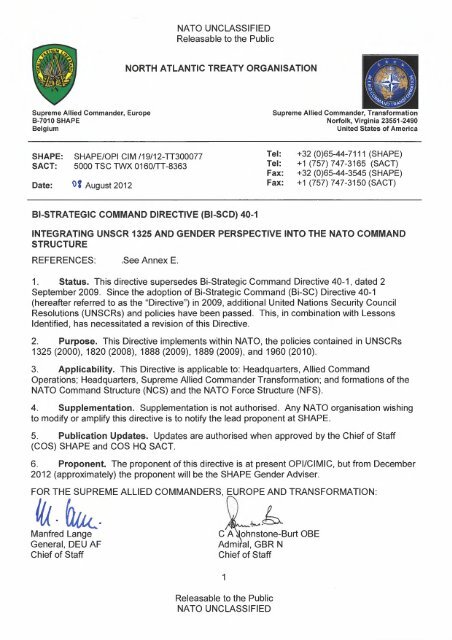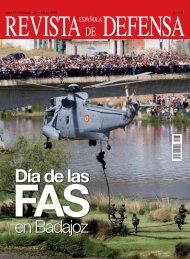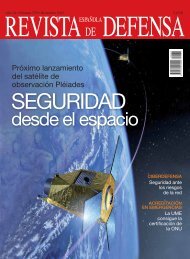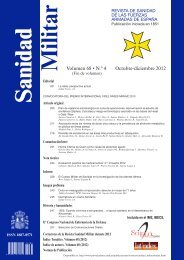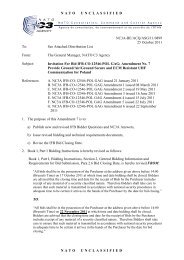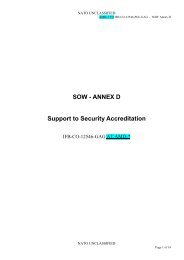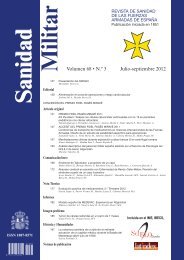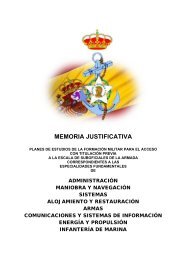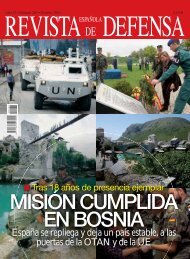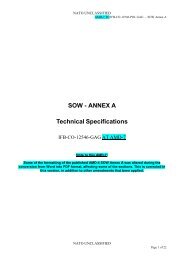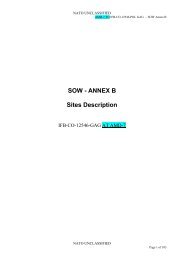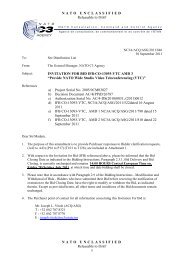~Ht;;:_~ME ALLIEDCOMMANDERS,ÃRO~b ... - Nato
~Ht;;:_~ME ALLIEDCOMMANDERS,ÃRO~b ... - Nato
~Ht;;:_~ME ALLIEDCOMMANDERS,ÃRO~b ... - Nato
You also want an ePaper? Increase the reach of your titles
YUMPU automatically turns print PDFs into web optimized ePapers that Google loves.
NATO UNCLASSIFIED<br />
Releasable to the Public<br />
NORTH ATLANTIC<br />
TREATY ORGANISATION<br />
Supreme Allied Commander, Europe<br />
B-7010 SHAPE<br />
Belgium<br />
Supreme Allied Commander, Transformation<br />
Norfolk, Virginia 23551-2490<br />
United States of America<br />
SHAPE: SHAPE/OPI CIM /19/12-TT300077<br />
SACT: 5000 TSC TWX 01601TT-8363<br />
Date: ~, August 2012<br />
Tel: +32 (0)65-44-7111 (SHAPE)<br />
Tel: +1 (757) 747-3165 (SACT)<br />
Fax: +32 (0)65-44-3545 (SHAPE)<br />
Fax: +1 (757) 747-3150 (SACT)<br />
BI-STRATEGIC COMMAND DIRECTIVE (BI-SCD) 40-1<br />
INTEGRATING UNSCR 1325 AND GENDER PERSPECTIVE INTO THE NATO COMMAND<br />
STRUCTURE<br />
REFERENCES: .See Annex E.<br />
1. Status. This directive supersedes Bi-Strategic Command Directive 40-1, dated 2<br />
September 2009. Since the adoption of Bi-Strategic Command (Bi-SC) Directive 40-1<br />
(hereafter referred to as the "Directive") in 2009, additional United Nations Security Council<br />
Resolutions (UNSCRs) and policies have been passed. This, in combination with Lessons<br />
Identified, has necessitated a revision of this Directive.<br />
2. Purpose. This Directive implements within NATO, the policies contained in UNSCRs<br />
1325 (2000), 1820 (2008), 1888 (2009),1889 (2009), and 1960 (2010).<br />
3. Applicability. This Directive is applicable to: Headquarters, Allied Command<br />
Operations; Headquarters, Supreme Allied Commander Transformation; and formations of the<br />
NATO Command Structure (NCS) and the NATO Force Structure (NFS).<br />
4. Supplementation. Supplementation is not authorised. Any NATO organisation wishing<br />
to modify or amplify this directive is to notify the lead proponent at SHAPE.<br />
5. Publication Updates. Updates are authorised when approved by the Chief of Staff<br />
(COS) SHAPE and COS HQ SACT.<br />
6. Proponent. The proponent of this directive is at present OPI/CIMIC, but from December<br />
2012 (approximately) the proponent will be the SHAPE Gender Adviser.<br />
F~ <strong>~Ht</strong>;;:_<strong>~ME</strong> <strong>ALLIEDCOMMANDERS</strong>, ÜRO~b<br />
TRANSFORMATION:<br />
Manfred Lange c~nstone-Burt OBE<br />
General, DEU AF<br />
Admiral, GBR N<br />
Chief of Staff<br />
Chief of Staff<br />
1<br />
Releasable to the Public<br />
NATO UNCLASSIFIED
Bi-SC 40-1 REV 1<br />
TABLE OF CONTENTS<br />
NATO UNCLASSIFIED<br />
REL TO PUBLIC<br />
SUBJECT<br />
CHAPTER 1 - INTRODUCTION<br />
Aim<br />
Rationale<br />
UN and NATO Framework<br />
Key Definitions<br />
Concepts of Integration<br />
CHAPTER 2 - EDUCATION AND TRAINING<br />
General<br />
Education and Training Policy<br />
Education and Training Programme Framework<br />
Gender Requirements Authority<br />
Gender Department Head<br />
Training Management<br />
General Compliance<br />
GENAD/ GFA Training<br />
Pre-Deployment Training<br />
CHAPTER 3 -IMPLEMENTATION<br />
General<br />
Aim<br />
Gender Balance Within NATO Forces<br />
Operational Planning and Preparation<br />
Standards of Behaviour<br />
Tactical Considerations<br />
Reporting<br />
ANNEXES:<br />
PAGE NO<br />
3<br />
3<br />
3<br />
4<br />
5<br />
6<br />
8<br />
8<br />
8<br />
8<br />
8<br />
8<br />
8<br />
8<br />
9<br />
10<br />
11<br />
11<br />
11<br />
11<br />
11<br />
12<br />
12<br />
13<br />
PARA NO<br />
1-1<br />
1-2<br />
1-3<br />
1-4<br />
1-5<br />
2-1<br />
2-2<br />
2-3<br />
2-4<br />
2-5<br />
2-6<br />
2-7<br />
2-8<br />
2-9<br />
3-1<br />
3-2<br />
3-3<br />
3-4<br />
3-5<br />
3-6<br />
3-7<br />
A. Gender Advisor and Gender Field Advisor, Roles and Responsibilities.<br />
B. NATO Standards of Behaviour.<br />
C. ACT Education and Training Programme Framework.<br />
D. Reporting of Gender Perspective in Operations.<br />
E. References.<br />
2<br />
NATO UNCLASSIFIED<br />
REL TO PUBLIC
Bi-SC 40-1 REV 1<br />
CHAPTER 1<br />
INTRODUCTION<br />
NATO UNCLASSIFIED<br />
REL TO PUBLIC<br />
1-1. Aim. This Bi-SC Directive aims to ensure implementation of United Nations Security<br />
Council Resolution (UNSCR) 1325, related resolutions and integration of gender perspective<br />
military organisations and forces in the NATO Command Structure (NCS) and NATO Force<br />
Structure (NFS) of the Alliance and within NATO-led operations.<br />
in<br />
1-2. Rationale. Security and risks during armed conflicts are perceived differently by men,<br />
women, boys and girls 1. These differences must be analysed and addressed to enable a safe,<br />
secure and stable environment for the entire population. An effective operational response uses<br />
Comprehensive Approach (CA) principles to address multi-faceted conflicts and crises, and<br />
contribute to sustainable and lasting peace. Realising that gender dimensions are an important<br />
component of such efforts, this Directive seeks to mainstream gender into all phases of NATO<br />
activities.<br />
a. NATO recognises that women, girls and boys are potentially more vulnerable to<br />
threats, intimidation and assaults during armed conflict including sexual and genderbased<br />
violence (SGBV) and sexual exploitation and abuse. In addition, sexual violence<br />
can be used as a strategic weapon of war, wherein rape, forced prostitution, sexual<br />
enslavement, forced sterilisation, mutilation and other forms of sexual violence serve to<br />
terrorise, displace and even ethnically cleanse a population. Specific attention should be<br />
given to provide special protection and uphold the freedom of movement for women and<br />
girls. In order to strengthen women's, girls' and boys' rights and security, women in<br />
particular must be involved and represented at all stages of a decision-making process,<br />
including peace processes, stabilisation and security measures in the political and<br />
economic spheres.<br />
b. Gender perspective is a tool to increase operational effectiveness. By identifying<br />
an often overlooked populace, recognising their specific needs, and providing the<br />
appropriate comprehensive response, the operational environment is positively<br />
influenced. NATO has therefore adopted a policy of gender mainstreaming, integration of<br />
gender perspective and more adequate protection of women, girls and boys during<br />
armed conflict. As such, this Directive provides a strategy for recognising the need to<br />
protect the entire society; but primarily highlights the specific concerns security, risks and<br />
experiences of women, girls and boys. This strategy should be utilised in the design,<br />
implementation, monitoring and evaluation of all policies and programs.<br />
c. This Directive provides guidance for the integration of Resolutions, Conventions,<br />
Protocols and gender perspective into the planning and conduct of NATO-led operations.<br />
It establishes and clarifies the role of Gender Advisor (GENAD), Gender Field Advisor<br />
(GFA) and Gender Focal Point (GFP), as the providers of specific advice and operational<br />
support on gender dimensions to the Commander and NATO personnel. These roles and<br />
responsibilities are included as Annex A.<br />
1 Part I, Article 1 of The Convention on the Rights of the Child (20 November 1989), defines a child as below<br />
eighteen years of age.<br />
3<br />
NATO UNCLASSIFIED<br />
REL TO PUBLIC
Bi-SC 40-1 REV 1<br />
NATO UNCLASSIFIED<br />
REL TO PUBLIC<br />
d. North Atlantic Council (NAC) endorsement of the NATO Action Plan obligates all<br />
NATO members and partner nations to commit to UNSCR 1325 and related resolutions,<br />
conventions and protocols as part of NATO's wider policy objectives of enhancing<br />
security and stability. Through the uniform implementation of this Directive, gender<br />
mainstreaming and integration of gender perspective should become routine.<br />
e. Further to the above, NATO-led forces and commanders must not accept,<br />
condone, facilitate or commit acts of sexual exploitation and abuse of women or girls nor<br />
men and boys and must strive to prevent and respond to such conduct within its<br />
sanctioned power and authority. This Directive includes as Annex B Standards of<br />
Behaviour expected by NATO-led forces during operations and exercises.<br />
Consistent with the key concepts listed herein, requests by NATO to nations during forcegeneration<br />
and staffing conferences must call on gender mainstreaming and an<br />
increased gender balance in operations in line with the intentions and mandates of<br />
UNSCR 1325. Accordingly, requests for contributions may require the specific expertise<br />
of a qualified GENAD or females in functions engaging with the local population.<br />
1-3. United Nations and NATO Framework<br />
a. UNSCR 1325. UNSCR 1325 is the impetus for this Directive. On 31 October<br />
2000, the United Nations (UN) Security Council unanimously adopted Resolution 1325<br />
on Women, Peace and Security. It addresses the significant and disproportionate impact<br />
that armed conflict has on women and girls, as well as recognises the under-valued and<br />
under-utilised contributions women make to conflict prevention, peacekeeping, conflict<br />
resolution and peace-building. This Resolution stresses the importance of women's equal<br />
and full participation as active agents of peace and security. The focus of UNSCR 1325<br />
is Protection, Prevention, Participation and gender mainstreaming in order to achieve<br />
gender equality.<br />
b. UNSCR 1820. Building on UNSCR 1325, UNSCR 1820 was passed in 2008 and<br />
focuses on sexual violence in conflict. This Resolution acknowledges that sexual<br />
violence can and has been used as a tactic of war, with potentially destabilising<br />
consequences. Moreover, this Resolution pronounces sexual violence as "a war crime, a<br />
crime against humanity, or a constitutive act with respect to qenocide'". This designates<br />
that conflict-related sexual violence is a matter of security, and therefore must be<br />
handled and addressed by the military contribution. Furthermore, the UN Security<br />
Council requested the UN Secretary-General and troop contributing countries to UN<br />
peacekeeping missions to take measures in order to combat sexual violence.<br />
c. UNSCRs 1888, 1889 and 1960. Building on UNSCRs 1325 and 1820, several<br />
related resolutions were passed in 2009 and 2010. Taken altogether, all five of these<br />
resolutions create an international framework for the implementation of gender<br />
perspective in the pursuit of international security and the conduct of peace operations.<br />
d. NATO and EAPC Policy. NATO has adopted the Euro-Atlantic Partnership<br />
Council (EAPC) policy for the implementation of UNSCR 1325. This was followed by<br />
NATO action plans. Both the policy and the action plans have been revised. During the<br />
2 UNseR 1820/2008 paragraph 4<br />
4<br />
NATO UNCLASSIFIED<br />
REL TO PUBLIC
Bi-SC 40-1 REV 1<br />
NATO UNCLASSIFIED<br />
REL TO PUBLIC<br />
NATO Lisbon Summit in 2010, the Alliance called for a strong and effective<br />
implementation of UNSCR 1325 and related resolutions throughout all of its activities.<br />
The Chicago Summit Declaration, dated 20 May 2012, further reinforced this position by<br />
endorsing the Chairman's Strategic Progress Report' on mainstreaming UNSCR 1325<br />
and related resolutions into NATO-led Operations and Missions.<br />
1-4. Key Definitions<br />
In order to fully grasp this Directive, a basic understanding of some key definitions is crucial.<br />
These definitions lay the groundwork of how NATO's Strategic Commands (SCs) will integrate<br />
gender perspective, and UNSCR 1325 and related resolutions, in response to NATO's political<br />
and military commitments and expectations:<br />
a. Gender refers to the social attributes associated with being male and female<br />
learned through socialisation and determines a person's position and value in a given<br />
context. This means also the relationships between women and men and girls and boys,<br />
as well as the relations between women and those between men. These attributes,<br />
opportunities and relationships are socially constructed and are learned through<br />
socialisation processes. Notably, gender does not equate to woman.<br />
b. Gender mainstreaming is defined as a strategy to achieve gender equality by<br />
assessing the implications for women and men of any planned action, including<br />
legislation, policies and programmes in all areas and at all levels, in order to assure that<br />
the concerns and experiences of women and men are taken into account in the design,<br />
implementation, monitoring and evaluation of policies and programmes in all political,<br />
economic and societal spheres. This will lead to that women and men benefit equally and<br />
inequality is not perpetuated. Gender mainstreaming in this context represents the<br />
process to recognise and incorporate the role gender plays in relation to NATO's various<br />
operational missions. Gender mainstreaming does not focus solely on women, but the<br />
benefits of mainstreaming practices recognise their disadvantaged position in various<br />
communities.<br />
c. Integration of gender perspective is a way of assessing gender-based<br />
differences of women and men reflected in their social roles and interactions, in the<br />
distribution of power and the access to resources. In ACO and ACT activities it is used<br />
synonymously with implementing the requests of UNSCR 1325, related resolutions, as<br />
well as directives emanating from NATO. The aim of which is to take into consideration<br />
the particular situation and needs for men and women, as well as how the activities of<br />
NATO have different effects on them. More fundamentally, implementing a gender<br />
perspective is done by adapting action following a "gender analysis".<br />
d. Gender analysis is defined as the systematic gathering and examination of<br />
information on gender differences and social relations in order to identify and understand<br />
inequities based on gender. It could also be understood as "methods used to understand<br />
the relationship between men and women in the context of the society. For example,<br />
military planning activities should assess the different security concerns of women and<br />
men, girls and boys in the area of operation or take account of power relations in the<br />
3 PO(2012)0216<br />
5<br />
NATO UNCLASSIFIED<br />
REL TO PUBLIC
Bi-SC 40-1 REV 1<br />
NATO UNCLASSIFIED<br />
REL TO PUBLIC<br />
community to ensure women and men have equal access to assistance where the<br />
military is engaged in supporting humanitarian assistance. Other examples would include<br />
understanding how customary conflict-resolution mechanisms affect women and men<br />
differently and how their social status may change as a result of war."<br />
e. Gender equality refers to the equal rights, responsibilities and opportunities for<br />
women and men, and girls and boys. Equality does not mean that women and men will<br />
become the same, but that women's and men's rights, responsibilities and opportunities<br />
will not depend on whether they are born female or male.<br />
f. Sexual violence is when the perpetrator commits an act of a sexual nature<br />
against one or more persons or cause such person or persons to engage in an act of<br />
sexual nature by force, or by threat of force or coercion, such as that caused by fear of<br />
violence, duress, detention, psychological oppression or abuse of power, against such<br />
person or persons or another person, or by taking advantage of a coercive environment<br />
or such person's or persons' incapacity to give genuine consent."<br />
1-5. Concepts of Integration<br />
Working towards the full integration of gender perspective within NATO extends to the planning,<br />
execution and evaluation phases of NATO-led operations. All of these phases must be based<br />
on initial and regular analysis of social groups with a gender perspective.<br />
The following concepts shall be considered in the implementation of UNSCR 1325 and the<br />
integration of gender perspective:<br />
a. In the framework of the Comprehensive Approach, make sure that risks and<br />
security for the entire population will be addressed and handled.<br />
b. Establish and maintain liaisons with the local population, Non-Governmental<br />
Organisations (NGOs), and International Organisations (lOs) at strategic, operational and<br />
tactical levels, using the appropriate civil-military co-ordination mechanisms.<br />
c. Ensure that education and training, including pre-deployment training as outlined<br />
in Chapter 2 of this Directive, is conducted for all personnel in NATO-led operations.<br />
d. National programs are strongly encouraged to incorporate NATO pre-deployment<br />
gender training objectives (see Chapter 2) based on this Directive to ensure<br />
Interoperability in exercises and operations.<br />
e. Encourage NATO nations and partners to share best practices and support each<br />
others' efforts in national implementation of UNSCR 1325.<br />
4 See United Nations (2010), "Addressing Conflict-Related Sexual Violence - An Analytical Inventory of<br />
Peacekeeping Practice", New York, NY: United Nations, p. 5, for guidance on consequent action following a gender<br />
analysis.<br />
5 Elements of Crimes of the International Criminal Court.<br />
6<br />
NATO UNCLASSIFIED<br />
REL TO PUBLIC
Bi-SC 40-1 REV 1<br />
NATO UNCLASSIFIED<br />
REL TO PUBLIC<br />
f. Provide effective reporting and information sharing mechanisms between NATO<br />
and civilian organisations at the international level, as well as at local levels within the<br />
Comprehensive Approach framework.<br />
g. Ensure effective reporting and monitoring mechanisms regarding UNSCR 1325<br />
and related resolutions.<br />
h. Establish concepts, procedures and mechanisms to address and handle sexual<br />
violence in conflict as well as Human Security in general.<br />
i. For given operations, analyse measures available to protect against gender-based<br />
violence, particularly rape and other forms of sexual abuse and violence in situations of<br />
armed conflict.<br />
j. Ensure adherence to NATO Standards of Behaviour and United Nations' zero<br />
tolerance on Sexual Exploitation and Abuse (SEA) where applicable.<br />
k. Strive for a more gender balanced composition of workforce and expand the roles<br />
of women in operations and missions at all levels.<br />
I. Endeavour to increase representation of women throughout the NCS, (PE and<br />
CE) and the NFS.<br />
m. Strive for gender equality in the NFS in order to conduct credible and trustworthy<br />
external work and activities on women and gender in the Joint Operations Area (JOA).<br />
7<br />
NATO UNCLASSIFIED<br />
REL TO PUBLIC
Bi-SC 40-1 REV 1<br />
CHAPTER2<br />
NATO UNCLASSIFIED<br />
REL TO PUBLIC<br />
EDUCATION AND TRAINING<br />
2-1. General. The guidance contained in this Directive shall be linked to specific actions<br />
during peacetime as well as to NATO Comprehensive Operations Planning processes. The<br />
greatest effect is gained if gender perspective is included in the earliest forms of training and<br />
education and mainstreamed throughout courses at different levels to achieve lifelong learning.<br />
2-2. Education and Training Policy. This Directive shall be used in conjunction with the<br />
education and training program structures described in reference R Bi-SC Directive 75-2,<br />
Education, Training, Exercise, and Evaluation (ETEE) Directive, and should support national<br />
action plans. To promote interoperability, this Directive is consistent with current standards and<br />
action plans organised and directed by the United Nations Department of Peacekeeping<br />
Operations (UN DPKO) and the European Union (EU).<br />
2-3. Education and Training Programme Framework. In accordance with Reference S,<br />
ACT Education and Training (E& T) Programme Direction and Guidance No 1, all education and<br />
training initiatives shall follow the new ACT E&T Programme framework. This framework as it<br />
applies to the implementation of UNSCR 1325 and the integration of gender perspective in E&T<br />
is provided as Annex C and further detailed in para 2-8 below.<br />
2-4. Gender Requirements Authority. The Requirements Authority (RA) for the dimensions<br />
,concepts and scope of training gender as a capability is SHAPE Special Advisory Group (SAG)<br />
Requirements are formulated in dialogue with the NATO International Staff/Operations Division<br />
(IS/OPS) based on guidance from Operational Planning Committee (OPC), and in consideration<br />
of training needs as may be identified by Operational Commanders.<br />
2-5. Gender Department Head. The Department Head (OH) for delivery of GENAD and<br />
GFA training is designated as the Nordic Centre for Gender in Military Operations (NCGM), a<br />
branch of the Swedish Armed Forces International Centre (SWEDINT).<br />
2-6. Training Management. On behalf of ACT Joint Force Trainer (JFT), the OH invites all<br />
gender perspective stakeholders (RA, Subject Matter Experts, ETFs and affiliated<br />
organisations) to the annual Gender E&T Conference for the purpose of course and content<br />
updates, co-ordination of national support and participation, operational feedback and<br />
discussion of recommendations regarding gender training programme development, goals and<br />
standards. JFT holds the final authority within the E&T framework for all gender training<br />
programme initiatives, analyses, changes and approval.<br />
2-7. General Compliance. NATO troops engaging with local populations during operations<br />
must be trained on UNSCR 1325 and related resolutions, gender perspective prior to<br />
deployment. Additional gender specific qualifications must be achieved in accordance with the<br />
CE training requirements. The following are minimum responsibilities of compliance:<br />
a. At all levels of the NCS, integrate UNSCR 1325 and related resolutions, and<br />
gender perspective into ETEE programs;<br />
b. Incorporate gender perspective training into courses at NATO Education and<br />
Training Facilities (NETFs), NATO Centres of Excellence (CoEs), Partnership Training<br />
8<br />
NATO UNCLASSIFIED<br />
REL TO PUBLIC
Bi-SC 40-1 REV 1<br />
NATO UNCLASSIFIED<br />
REL TO PUBLIC<br />
and Education Centres (PTECs) and National Training Institutions, and NATO in-theatre<br />
training centres related to capacity building, induction, mission and national training<br />
programs;<br />
c. Analyse education and training programs during periodic curriculum reviews to<br />
incorporate the most current related information and trends.<br />
d. Include UNSCR 1325 and gender dimensions in training for use in garrison and at<br />
deployed locations during operations, missions and exercises. Training should include<br />
gender and cultural/social awareness, overview of UNSCR 1325 and related resolutions<br />
and how they relate to operational effectiveness. Training should also emphasise zero<br />
tolerance for breaches of the NATO Standards of Behaviour for operations abuse and<br />
misconduct. For NATO-led operations, pre-deployment military training is the<br />
responsibility of the troop contributing nations. To assist in standardisation, it is<br />
requested that this training include the subjects listed above. All individuals being<br />
deployed will receive appropriate training through ACT's standardised and accredited<br />
pre-deployment training system.<br />
e. Ensure that entities working with local engagement (male or female) are well<br />
aware of the basics of UNSCR 1325 and related resolutions, as well as NATO policy and<br />
directives. All training curricula for female and male engagement capability should<br />
include paragraphs on these dimensions.<br />
f. Ensure that specifications, scenarios and objectives for NATO exercises and<br />
collective training includes gender perspective based on UNSCR 1325 and related<br />
resolutions.<br />
g. Ensure that the evaluations of NATO HQs, exercises and collective training events<br />
assess the integration and effects related to gender perspective and UNSCR 1325 and<br />
conducting training on UNSCR 1325 and gender perspective at all levels of the NCS.<br />
h. Regularly disseminate information (e.g. studies, lessons learned, best practices)<br />
and training materials to staff. Hold seminars and invite experts to provide informative<br />
lectures on associated topics.<br />
g. Monitor, review and analyse the effectiveness of UNSCR 1325, gender<br />
perspective and cultural awareness training programs (in garrison and deployed).<br />
Provide feedback via SACEUR and ACT annual reports and management plans if<br />
feasible.<br />
2-8. GENAD/GFA Training. Annex C identifies the mandatory and recommended training<br />
paths for GENADs and GFAs. This is a blended learning programme, combining Advanced<br />
Distributed Learning (ADL) with classroom instruction to create an optimum programme. The<br />
knowledge and skill needed to perform the appropriate level of gender related planning and<br />
operational application is achieved through various course offerings and depth of knowledge<br />
(DoK) levels (or levels of instruction) tailored to students' needs. Operational planning courses<br />
are included as "recommended" training, as GENADs and GFAs should be an integral part of<br />
JOPGs and SOPGs. GFPs are recommended as a minimum to complete the 100 level ADL<br />
training. An overarching Strategic Training Plan for gender is under development.<br />
9<br />
NATO UNCLASSIFIED<br />
REL TO PUBLIC
Bi-SC 40-1 REV 1<br />
NATO UNCLASSIFIED<br />
REL TO PUBLIC<br />
2-9. Pre-Deployment Training. Prior to new operations and missions NATO on Military<br />
Strategic and Operational level must as deemed appropriate give inputs and recommendations<br />
regarding gender dimensions on the specific area of operation. Incorporate lessons learned<br />
from NATO, EU, UN operations and missions, in addition to information from international<br />
women's and non-governmental organisations. Pre-deployment training should, at minimum,<br />
include:<br />
a. Highlighting the importance of protection, rights and needs of women, girls and<br />
boys;<br />
b. Providing information on how to engage with, and increase the participation of,<br />
local women and how to exchange information with women;<br />
c. Offering cultural awareness training based on an analysis of gender relations in<br />
the JOA;<br />
d. Demonstrating how integrating gender perspective can serve as a force enabler,<br />
and support the effectiveness of NATO-led operations; and<br />
e. Gaining an understanding of measures with respect to international law regarding<br />
the rights and protection of women and girls, especially civilians, during armed conflicts<br />
as well as NATO Standards of Behaviour (see Annex B).<br />
f. Pre-deployment training should aim to be specific and focused on the particular<br />
JOA, rather than generically 'raising awareness'.<br />
10<br />
NATO UNCLASSIFIED<br />
REL TO PUBLIC
Bi-SC 40-1 REV 1<br />
CHAPTER 3<br />
IMPLEMENTATION<br />
NATO UNCLASSIFIED<br />
IN OPERATIONS<br />
REL TO PUBLIC<br />
3-1. General. NATO operations must be planned and executed, as deemed necessary<br />
pending UNSCRs 1325, 1820, 1888, 1889 and 1960, as well as the Convention on the<br />
Elimination of all forms of Discrimination against Women (CEDAW) and NATO gender related<br />
policies, plans and directives listed at Annex E.<br />
3-2. Aim. Gender perspective is a tool used to better understand society as a whole. In order<br />
to achieve mission success and to reach the desired effects, NATO must fully understand its<br />
operational environment. This concept is of particular importance in relation to establishing<br />
stability and security.<br />
By implementing UNSCR 1325 and integrating gender perspective, a greater understanding of<br />
the positive effects on an operation can be achieved. In addressing the female part of the<br />
population, additional information (intelligence) and improved situational awareness is expected.<br />
Moreover, this offers a possibility to communicate with all groups and representatives of the<br />
local population. In doing so, knowledge of how resources can be concentrated and used most<br />
efficiently is gained. Gender perspective must be integrated and operationalised at all levels of<br />
planning and operations.<br />
3-3. Gender Balance within NATO Forces<br />
NATO-led operations can be more effective with enhanced women's participation at all levels.<br />
The experiences and skills of both men and women are essential to the success of NATO<br />
operations. Today's conflicts often require a Comprehensive Approach in terms of more tactful<br />
public relations, better and more extensive situational awareness, information operations,<br />
information gathering and intelligence production. Women in NATO-led forces can be an asset<br />
and an enabler, especially in activities of engagement with the local population. NATO-led<br />
operations will deploy the capacity and capability to engage with the entire population, men and<br />
women, girls and boys. It is optimal to have both a gender balanced force, and gender balanced<br />
teams. Gender engagement activities include, but are not limited to: CIMIC, HUMINT,<br />
information operations, psychological operations, investigations, medical services and public<br />
affairs.<br />
3-4. Operational Planning and Preparation<br />
Thorough planning and preparation for NATO operations are crucial steps for effective mission<br />
accomplishment. Integrating UNSCR1325 and gender perspective at all levels of planning is<br />
imperative when developing strategies to address the full spectrum of crisis management<br />
scenarios in which NATO is involved.<br />
The Alliance recognises that women's perspectives, insights and skills add value across all its<br />
activities. During NATO operations, it is important to obtain a clear understanding of the local<br />
culture, society and environment (i.e. context) which include a gender dimension. It is also<br />
essential to take measures to promote gender equality relevant to the operation. When<br />
understanding the local context, it is of highest importance to listen to, take advice and<br />
recommendations from both women and men. NATO-led forces must understand the cultural<br />
context within which they are operating and not simply apply their own norms, law and<br />
behaviour. However the distinction between international and local law, human rights and<br />
11<br />
NATO UNCLASSIFIED<br />
REL TO PUBLIC
Bi-SC 40-1 REV 1<br />
NATO UNCLASSIFIED<br />
REL TO PUBLIC<br />
culture must be analysed and addressed. Lessons Learned indicate that a gender-mixed force<br />
enhances the sharing of information, knowledge, intelligence, and is instrumental in garnering<br />
trust and credibility.<br />
With respect to UNSCR 1325 and gender perspective, the planning, execution and evaluation of<br />
NATO-led operations must focus on the functions listed below (specific roles and responsibilities<br />
are included as Annex A):<br />
a. Utilise GENAD expertise early and throughout the planning process to ensure the<br />
full integration of UNSCR 1325 and gender perspective. GENADs should provide subject<br />
matter expertise to planners and commanders on UNSCR 1325 and gender dimensions.<br />
This knowledge should be based on a gender analysis specific to areas of operation. A<br />
gender analysis should be done prior to any operational planning process. It will be part<br />
of situational awareness (for the specific JOA). Work and achievements obtaining<br />
situational awareness should always include a gender perspective.<br />
b. During force generation and CE manning conferences specify GENADs'<br />
requirements. Must ensure the participation of women on tactical and operational<br />
positions in order to engage with the entire population at all times.<br />
c. GENADs should provide subject matter expertise on procedures to protect<br />
civilians, with specific consideration given to women, girls and boys, from violence, rape<br />
and other forms of sexual abuse, including the trafficking of human beings. This is in<br />
compliance with UNSCRs 1325, 1820 and related resolutions.<br />
d. Ensure a gender perspective in all capacity building efforts supporting, training<br />
and menta ring local security forces.<br />
e. NATO Operational Plans (OPLANs) shall include a description of the NATO<br />
Standards of Behaviour (see Annex B), provisions on Combating Trafficking in Human<br />
Beings (Reference M), as well as a specific Gender Annex. References 0 and N give<br />
specific guidance on NATO Operational Planning and will provide for addressing and<br />
integrating gender perspective.<br />
3-5. Standards of Behaviour<br />
NATO operations may be tasked through a UN Security Council mandate to protect the<br />
population. Operations are also deployed based on democratic and human rights core values.<br />
NATO personnel in any position should always act as a role model. Sexual Exploitation and<br />
Abuse (SEA), addressed in UNSCR 1820, damages the image and integrity of any operation. It<br />
erodes the trust and confidence in NATO operations.<br />
As noted in Chapter 1, NATO-led forces and commanders must not accept, condone, facilitate<br />
or commit acts of sexual exploitation and abuse and must strive to prevent and respond to such<br />
conduct within its sanctioned power and authority. This Directive includes as Annex B<br />
Standards of Behaviour expected by NATO-led forces during operations and exercises.<br />
3-6. Tactical Considerations<br />
12<br />
NATO UNCLASSIFIED<br />
REL TO PUBLIC
Bi-SC 40-1 REV 1<br />
NATO UNCLASSIFIED<br />
REL TO PUBLIC<br />
Patrolling provides opportunities to engage with the local population in order to enhance<br />
information gathering for the operation. In doing so, they develop a more comprehensive picture<br />
of the local situation. Local consultations with women can also help address specific protection<br />
concerns for women and girls, such as vulnerability to sexual violence and trafficking in human<br />
beings.<br />
For example, collecting water and firewood are highly gendered activities in many conflict<br />
affected areas. Women and girls often bear the primary responsibility for these outdoor<br />
activities. This is significant from a security perspective because while they conduct their<br />
outdoor activities, women and girls may be the first to observe actions that might affect the<br />
security environment. Their perspectives can enhance the mission's understanding of the<br />
security environment on a daily basis. In addition, collecting firewood, fetching water, and<br />
attending public markets to buy food, can expose women and girls to security risks such as<br />
rape, assault, and kidnapping. Therefore, consultation with women and women's organisations<br />
is essential in the planning of patrol routes and schedules when trying to improve security. Such<br />
consultation is crucial, as measures taken to protect women and girls without consultation often<br />
result in ineffective or counterproductive effects.<br />
3-7. Reporting<br />
Strong and effective monitoring and reporting mechanisms should always be in place, making<br />
sure that human rights violations, SGBV and indications of domestic or international trafficking<br />
of human beings are reported, addressed and handled. Suggested questions to be considered<br />
when reporting are listed in Annex D, Reporting of Gender Perspective in Operations.<br />
To the greatest extent possible, this reporting should be included/integrated with other standard<br />
JOA reporting procedures. Reports should include information about the situation of women,<br />
boys and girls; the impact of NATO interventions on women, men, girls and boys; and statistics<br />
disaggregated by sex. In addition to regular reporting procedures, reports may also include oral<br />
briefings, progress reports, or thematic reports. In Periodic Mission Reviews (PMRs), gender<br />
should be specifically addressed.<br />
13<br />
NATO UNCLASSIFIED<br />
REL TO PUBLIC
NATO UNCLASSIFIED<br />
Releasable to the Public<br />
ANNEXA TO<br />
Bi-SCD 40-1 REV 1<br />
DATEDOVAUG 12<br />
GENDER ADVISOR AND GENDER FIELD ADVISOR - ROLES AND RESPONSIBILITIES<br />
The Gender Advisor serves in a peacetime HO and at strategic/operational levels,<br />
whereas the Gender Field Advisor is deployed at operational/tactical levels.<br />
1. Given that NATO commanders and their staffs are not yet trained and skilled in planning<br />
and execution of operations with an integrated gender perspective, Gender Advisors (GENADs)<br />
and Gender Field Advisors (GFAs) are needed to ensure that gender is an integrated part of<br />
planning operations. GENAD and GFA positions are full-time positions that require adequate<br />
training, education and experience.<br />
2. Every revision of the NATO Peacetime Establishment (PE) and CE structure must<br />
include considerations to appoint GENADs and GFAs. This is to ensure integration and a<br />
common understanding of UNSCR 1325 and gender dimensions. GENADs and GFAs should<br />
be posted throughout the NCS, including deployable/deployed HOs, as well as in exercises.<br />
3. The GENAD advises upon request, as well as when he/she considers it appropriate. The<br />
GENAD should always be a member of a planning group, for example, the Strategic<br />
Operational Planning Group (SOPG), or the Joint Operational Planning Group (JOPG).<br />
4. The GENAD should have direct access to the Commander/Command Group in order to<br />
be able to communicate timely and directly with decision makers. This underlines gender<br />
perspective as a cross functional area. The GENAD maintains functional contact with other<br />
GENADs, GFAs and GFPs in higher and subordinate commands.<br />
5. The roles and responsibilities of a GENAD will be described in the Standard Operating<br />
Procedures (SOPs). The SOP should be tailored to respective HO and/or operation. This list is<br />
not all-inclusive, but will normally include the following:<br />
a. Requirement that the GENAD/GFA reports directly to the Commander and provide<br />
support to ensure that planning, execution and evaluation properly integrate gender<br />
perspective.<br />
b. As an integral part of an HO or deployed commander's staff, GENADs must<br />
establish, maintain relationships and liaise with all elements of the staff to facilitate the<br />
integration of UNSCR 1325 and gender perspective.<br />
c. Support operational objectives and activities in the respective JOA regarding local<br />
security forces e.g. recruitment of women, assisting national security forces, supporting<br />
creation of local structures retaining women, training as well as education.<br />
d. Assess the different security risks of men and women in monitoring and evaluation<br />
activities.<br />
A-1<br />
Releasable to the Public<br />
NATO UNCLASSIFIED
Bi-SCD 40-1 REV 1<br />
NATO UNCLASSIFIED<br />
Releasable to the Public<br />
e. Support different staff functions on how to integrate gender perspective into their<br />
respective tasks and products.<br />
f. Conduct and disseminate a Gender Analysis to ensure that gender dimensions<br />
are part of the on-going work to gain situational awareness.<br />
g. In the framework of Comprehensive Approach, co-operate by sharing information<br />
and co-ordinating activities with international community actors in-theatre, including lOs<br />
and NGOs. The GENAD should also facilitate interaction between international<br />
community actors working on UNSCR 1325 and gender. These activities should be coordinated<br />
as outlined within the particular SOP for the specific Ha.<br />
h. Support and enable local law, directives and commitments related to UNSCR<br />
1325 and related resolutions, women and gender perspective.<br />
i. Support the Commander, J1 and LEGAD with any inquiry or investigation initiated<br />
by the Commander concerning a breach of NATO Standards of Behaviour, or an<br />
allegation of violence, rape, or other forms of sexual abuse.<br />
j. Support a gender balanced force, and in particular, ensure that women are part of<br />
the regular force structure. It is necessary to conduct frequent and flexible engagement<br />
with the male as well as female part of the local population.<br />
k. Special attention should also be given to organisations and groups defending<br />
women's and children's human rights.<br />
6. The following is a list of staff responsibilities (not ali-inclusive), where the GENAD should<br />
focus their liaison and support efforts:<br />
a. J1. Advise on gender dimension in policy, standards of conduct and recruitment to<br />
ensure an improved gender-balance and the hiring of local employees in garrison and inmission<br />
training. Human Resource Management (HRM) should share gender-related<br />
statistics.<br />
b. J2. Address gender perspectives which may impact information collection (i.e.,<br />
HUMINT, risk assessments), knowledge development, analysis and production. GENAD<br />
should conduct gender analyses and assessments supported by information collection.<br />
c. J3. Assist assessments regarding women's security situations and gender<br />
analysis, supporting the planning and execution of operations. For example, Information<br />
Operations, Psychological Operations, patrols, and search operations. Ensure a genderbalanced<br />
approach to efforts during Key Leader Engagement. GENAD must be informed<br />
on gender-related activities, plans and assessments.<br />
d. J4. Support medical and logistical matters, as well as implementing gender<br />
perspective into compounds. GENAD should support the planning and assessment of<br />
logistical activities impacting gender relations, for example, building facilities,<br />
communications, etc.<br />
A-2<br />
Releasable to the Public<br />
NATO UNCLASSIFIED
Bi-SCD 40-1 REV 1<br />
NATO UNCLASSIFIED<br />
Releasable to the Public<br />
e. J5. Support the campaign plan, operational design and long-term planning with<br />
the integration of gender perspective. Take part in the planning process, and provide<br />
subject-matter expertise. GENAD is responsible for drafting gender annexes and<br />
appendices. GENAD will support gender-related assessments and planning<br />
considerations.<br />
f. J7. Provide guidance with reference to embedding UNSCR 1325 and gender<br />
awareness into collective training and exercises. Advice should also extend to include all<br />
national pre-deployment training.<br />
g. J9/CIMIC. Support and provide guidance regarding engagement and liaison with<br />
the female part of the population as well as women's organisations. Special attention<br />
needs to be given to women's organisations. They need to be provided with an<br />
opportunity to meet and engage with different parts of the NATO-led operation,<br />
depending on what topic/area is to be addressed. Note: it is ineffective if the GENAD or<br />
J9/CIMIC becomes the sale point(s) of contact for women and women's organisations.<br />
h. LEGAD. Advise on gender dimensions in the judicial system, according the<br />
relevant UNSCRs and beyond. Provide relevant information where women, girls and<br />
boys legal rights are neglected and/or violated.<br />
i. STRATCOM. Advise on inclusion of gender appropriate content and gender<br />
specific messages as required. Since STRATCOM facilitates co-ordination of strategic<br />
messaging, it is important to ensure that GENAD content is included in messages at all<br />
levels to improve integration of gender perspective in all appropriate messages<br />
disseminated by NATO.<br />
7. Gender Focal Point (GFP). The GFP is a dual-hatted position that supports the<br />
Commander in implementing directives and procedures with gender perspective. The GFP<br />
maintains functional dialogue with the GENAD, but reports within the chain of command. The<br />
GFP at the tactical level ensures that gender perspective is fully integrated into the daily tasks<br />
of the operation. These activities could include, but are not limited to: patrolling, enabling the<br />
provision of humanitarian aid, search procedures, assisting national security forces, assessing<br />
the different security risks of men and women in monitoring and evaluation activities, and<br />
providing gender training for NATO personnel.<br />
A-3<br />
NATO UNCLASSIFIED<br />
REL TO PUBLIC
NATO UNCLASSIFIED<br />
Releasable to the Public<br />
ANNEX B TO<br />
Bi-SCD 40-1 REV 1<br />
DATED01 AUG 12<br />
NATO STANDARDS<br />
OF BEHAVIOUR<br />
1. Compliance. NATO forces must internally and externally uphold and adhere to high<br />
moral and human standards. Any form of abuse, exploitation and harassment should never be<br />
accepted. A soldier abusing or mistreating colleagues internally, cannot be trusted conducting<br />
tasks properly externally. Commanders and forces are obligated to prevent and respond to such<br />
conduct within their sanctioned power and authority.<br />
Sexual Exploitation: any actual or attempted abuse of a position of vulnerability,<br />
differential power or trust for sexual purposes, including profiting monetarily, socially<br />
or politically.<br />
Sexual Abuse: actual or threatened<br />
other coercive conditions.<br />
physical act of sexual nature either by force or<br />
2. Scope. These Standards refer to individual conduct on and off-duty. They provide<br />
Commanders the means to consistently enforce good order and discipline among NATO forces<br />
and personnel. These standards are not intended to replace or restrict national policies, but are<br />
provided to depict the standards of professionalism and the high expectations Alliance and<br />
partner nations have for the performance of NATO personnel. Operational Commanders have<br />
the authority to establish stricter rules and tailor their guidance to best meet the specific<br />
operation. To clarify, the GFA works in co-ordination with Human Resources (HRlJ1) to report to<br />
the Commander regarding gender balance and breaches of regulations containing gender<br />
dimensions; for example, sexual abuse or harassment. HRlJ1 solely reports to the Commander<br />
regarding the recruitment of women into NATO forces, as well as the recruitment of local men<br />
and women. Issues on breaches of internal standards, NATO Standards of Behaviour, internal<br />
abuse and harassment are handled by LEGAD together with HRlJ1.<br />
3. Policy. Given the multicultural environment of the Alliance, every person must respect<br />
each other. Accordingly, disrespect and a lack of professionalism are unacceptable, and can<br />
adversely impact morale. As such, the regular activities of International Military Headquarters of<br />
the Alliance, Heads of NATO Bodies subordinate to ACO and ACT in the NCS are directed to<br />
implement procedures in references V through X as applicable. These documents detail the<br />
codes and conduct and informal and formal mechanisms to aid individuals in resolving<br />
complaints.<br />
4. Investigation. When allegations are made, or incidents that breach the Standards occur<br />
or involve harm to civilians (with specific consideration given to women and children, from<br />
violence, rape and other forms of sexual exploitation or abuse), NATO force commanders will<br />
appoint an investigation officer to conduct a fact-finding/preliminary inquiry within 72 hours of<br />
notice. NATO Civilian Personnel Regulations and ACO Directive 50-11 (Deployment of NATO<br />
Civilians), shall apply in a case involving NATO civilian personnel.<br />
B-1<br />
Releasable to the Public<br />
NATO UNCLASSIFIED
Bi-SCD 40-1 REV 1<br />
NATO UNCLASSIFIED<br />
Releasable to the Public<br />
5. Reporting and Resolution. Results will be reported through the chain of command up to<br />
the SHAPE Strategic Direction Centre for inclusion in the daily operational report to the SHAPE<br />
Command Group:<br />
a. If the allegation is unfounded or the incident has no merit, the inquiry will be<br />
closed without prejudice of any action vis-à-vis person(s) falsely accusing NATO<br />
personnel.<br />
b. If the allegation or incident has merit, the Force Commander will forward the<br />
results of the preliminary inquiry for disciplinary action to the appropriate national<br />
authority. The Commander and national authorities should work closely to ensure proper<br />
resolution.<br />
c. Final disposition should be reported in-parallel through national and NATO chains<br />
of command.<br />
d. Appropriate J1, Provost Marshal, LEGAD, POLAD, and PAO personnel will work<br />
in close co-ordination while investigating or responding to the allegation or incident.<br />
Representatives Should:<br />
• Conduct ourselves in a professional and disciplined manner, at all times.<br />
• Display the highest levels of integrity, dignity, and respect.<br />
• Respect the local laws, customs and practice through awareness and<br />
respect for the culture, religion, traditions and gender issues.<br />
• Adhere to the procedures and rules of engagement set out by our chairi of<br />
command.<br />
• Not bring discredit upon NATO through improper personal conduct, failure<br />
to perform.dutiesor abuse of our positions.<br />
• Not commit any illegal act of unnecessary violence or threat to anyone in<br />
custody;<br />
• Not commit any act that could result in physical, sexual or psychological<br />
harm or suffering, especiallyrelàted to women and children.<br />
• Not abuse alcohol, use or traffic drugs.<br />
• Be respectful of the local population.<br />
• Have pride in our position as a representative of NATO and never abuse or<br />
misuse your authority.<br />
B-2<br />
Releasable to the Public<br />
NATO UNCLASSIFIED
NATO UNCLASSIFIED<br />
Releasable to the Public<br />
ANNEX C TO<br />
Bi-SCD 40-1 REV 1<br />
DATED O( AUG 12<br />
ACT EDUCATION AND TRAINING PROGRAMME FRAMEWORK<br />
0)<br />
c<br />
E<br />
E<br />
CU<br />
t....<br />
~<br />
O)e..<br />
C<br />
.- '"0<br />
.-<br />
C<br />
c:<br />
CU è'O<br />
t....<br />
I--<br />
ode<br />
en<br />
c: ID<br />
o E<br />
+=i ~<br />
co<br />
(.) ,:::J<br />
:::J c-<br />
'"0 ID<br />
wO::<br />
Q)<br />
o<br />
c<br />
co<br />
"C<br />
::::I<br />
(.9<br />
~<br />
c<br />
0<br />
':.ï=i<br />
-<br />
(.)<br />
E<br />
Q)<br />
,_<br />
Q)<br />
.-<br />
Cl<br />
~<br />
Cf)<br />
,_ ~<br />
......<br />
ell<br />
:t-'. Q)<br />
:f! E<br />
Q)<br />
ro<br />
-<br />
0)<br />
ell<br />
(.) c<br />
;:; ell<br />
0<br />
::E<br />
a..<br />
.0)<br />
c:<br />
C<br />
c.<br />
ro ,_<br />
I-<br />
~ ,<br />
(.)<br />
C-1<br />
Releasable to the Public<br />
NATO UNCLASSIFIED
Bi-SCD 40-1 REV 1<br />
NATO UNCLASSIFIED<br />
Releasable to the Public<br />
Gender Programme<br />
Gender Advisor<br />
Gender Field Advisor<br />
&ertisés<br />
C-2<br />
C-2<br />
Releasable to the Public<br />
NATO UNCLASSIFIED
NATO UNCLASSIFIED<br />
Releasable to the Public<br />
ANNEXDTO<br />
Bi-SCD 40-1 REV 1<br />
DATED\>9AUG 12<br />
REPORTING OF GENDER PERSPECTIVE IN OPERATIONS<br />
The following<br />
is a list of questions that should be considered when reporting:<br />
a. How does the security situation affect women, men, girls and boys?<br />
b. What risks, similar and/or different do men, women, girls and boys face?<br />
c. What are the differences in vulnerabilities between these groups (women, men,<br />
girls and boys)?<br />
d. Are women's and men's security issues known, and are their concerns being met?<br />
Assess security issues also for different women; for example, women as politicians,<br />
activists or Human Rights Defenders, including Women's Human Rights Defenders.<br />
e. What role do women play in the military, armed groups, police or any other<br />
security institutions such as intelligence services, border policy, customs, immigration, or<br />
other law enforcement services (per cent of forces/groups, by grade and category)?<br />
f. What role do women play in the different parts of and social groups in the society?<br />
g. Does the selection and interaction between local power holders and the operation<br />
affect women's ability to participate in society - such as legal, political or economic<br />
spheres?<br />
h. Gender disaggregated data on for example; political participation, education,<br />
refugees, prisoners, health related issues, refugees, SGBV etc.<br />
i. Assessment of the current situation and planned actions.<br />
D-1<br />
Releasable to the Public<br />
NATO UNCLASSIFIED
NATO UNCLASSIFIED<br />
Releasable to the Public<br />
ANNEX E TO<br />
Bi-SCD 40-1 REV 1<br />
DATED QfJAUG 12<br />
REFERENCES<br />
A. United Nations Security Council Resolution 1325 (2000).<br />
B. United Nations Security Council Resolution 1820 (2008).<br />
C. United Nations Security Council Resolution 1888 (2009).<br />
D. United Nations Security Council Resolution 1889 (2009).<br />
E. United Nations Security Council Resolution 1960 (2010).<br />
F. United Nations Security Council Resolution 1674 (2006).<br />
G. United Nations Security Council Resolution 1261 (1999).<br />
H. United Nations Security Council Resolution 1314 (2000).<br />
I. United Nations Security Council Resolution 1612 (2005).<br />
J. 1949 Geneva Convention IV Relative to the Protection of Civilians Persons in Time of<br />
War.<br />
K. 1977 Protocol Additional to the Geneva Conventions of 1949 and Relating to the<br />
Protections of Victims of International Armed Conflicts (Protocol I).<br />
L. Euro-Atlantic Partnership Council Document EAPC(C)D(2007)0022, Implementing<br />
UNSCR 1325 on Women, Peace, and Security, dated 10 December 2007 and July 2011.<br />
M. IMSM-0217-2011, NATO Policy on Combating Trafficking in Human Beings, dated 21<br />
Apri12011.<br />
N. ACO Comprehensive Operational Planning Directive dated 17 December 2010.<br />
O. ACO Directive 50-11, Deployment of NATO Civilians, dated 30 June 2010.<br />
P. Lisbon Summit Declaration dated 20 November 2010.<br />
Q. Chicago Summit Declaration dated 20 May 2012.<br />
R. PO(2012)0020, Chairman's Progress Report on Implementing NATO/EAPC Policy on<br />
UNSCR 1325 and Related Resolutions, dated 17 May 2012.<br />
S. Bi-SC Directive 75-2, Education, Training, Exercise and Evaluation, dated 18 February<br />
2010.<br />
T. ACT NU Document 5000ITPX031 0, Education and Training Programme Management<br />
Direction and Guidance No 1, dated 8 March 2012.<br />
U. Convention on the Elimination of all forms of Discrimination Against Women (CEDAW),<br />
signed at New York on 18 December 1979 (entry into force 3 September 1981).<br />
V. SHAPE Directive 50-9, Discrimination and Harassment in the Workplace.<br />
W. ACT Directive 40-1, ACT Standards of Personal Conduct.<br />
X. (2010)0016-26, NATO Code of Conduct, dated March 2010.<br />
Y. ACO Policy Statement on Discrimination and Harassment in the Workplace dated 23<br />
February 2006.<br />
Z. NCSA Directive 40-7 Standards of Conduct.<br />
AA. AAP-6(V2012), NATO Glossary of Terms and Definitions.<br />
BB. United Nations Declaration (53/144) Declaration on the Right and Responsibility of<br />
Individuals, Groups and Organs of Society to Promote and Protect Universally Recognised<br />
Human Rights and Fundamental Freedoms dated 8 March 1999.<br />
CC. Convention on the Rights of the Child dated 20 November 1989 and two Optional<br />
Protocols to the Convention on the Rights of the Child dated 2000.<br />
E-1<br />
Releasable to the Public<br />
NATO UNCLASSIFIED


